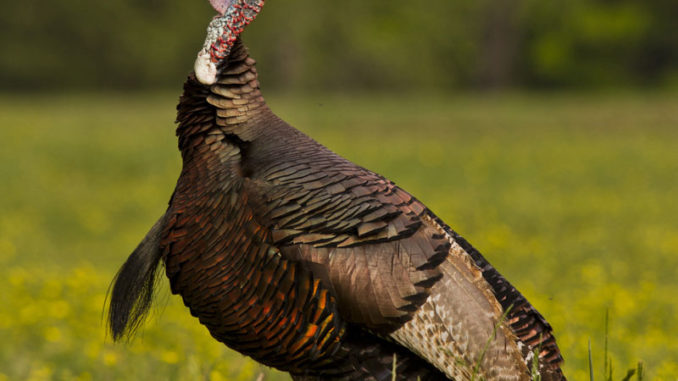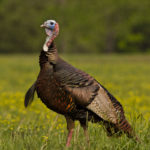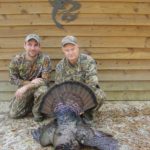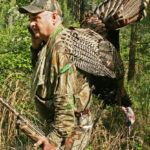
Changes in turkey behavior should force South Carolina hunters to change their tactics as April progresses.
Hunting turkeys effectively through an entire season is one of the biggest challenges for a hunter — emphasis on effectively.
Everyone enjoys and many have success the first week to 10 days after hunting begins, but beyond that, interest for a lot of hunters wanes for a variety of factors, not the least of which is the fact that hunting becomes more difficult.
Often, hunters contribute to their own troubles by continuing to use the same tactics in the same places that worked the first week. The mood of a gobbler doesn’t really change, it’s actually the biology of the birds that dictate almost continuous change by gobblers and hens during the season. Unless changes are made by hunters the probability of being an effective turkey hunter throughout the season is diminished.
Charles Ruth, the deer and turkey project leader for the S.C. Department of Natural Resources, said turkeys undergo dramatic changes during the few weeks of the season.
“For a lot of the year, turkeys are fairly consistent in their nature and routine,” he said. “However, during breeding season — which coincides with hunting season — there are big changes constantly ongoing. The gobblers begin gobbling to attract hens, and hens respond, and as they go through the breeding process, there will be a peak of gobbling activity, then a peak of breeding when there is less gobbling and the term ‘henned up’ is accurate. As hens lay eggs and finish the egg laying process by mid-to late-season, they begin sitting on nests to incubate eggs.
“Essentially, gobblers that had plenty of hens often find it more difficult to find hens because many are sitting on nests. Along each step of this process, there are changes in turkey behavior that dictate turkey hunting behavior. It’s dramatic in that it occurs in such a fast-paced manner.”
In short, hunters must adept to the birds’ changing moods, but if they do, success is likely to follow.
Brian Jordan, 38, is a guide for Blackwater Hunting Services in Ulmer who said changing tactics as the season progresses is essential to effectively put clients on gobblers.
“I’ve been guiding for 20 years in South Carolina and have learned that turkeys are constantly changing their behavior during the season, both gobblers and hens,” Jordan said. “Actually, one of the keys to consider is that it’s more of what the hens do that dictate changes in gobbler behavior. But early in the season, a lot of hunters enjoy success because gobblers are establishing dominance, both in the Lowcountry season and even in the early April season for most of the state.”
Jordan (803-671-4868) said that as gobblers establish dominance early in the season, they’ll gobble more frequently and will often respond to calling quicker.
“There are a couple of things in play,” he said. “First, there are the early-season, unpressured birds willing to go against nature and go to hens — actually, a hunter making hen sounds — especially if dominance has not been established. This can be a good time to use decoys, especially the gobbler decoy, and to even use gobbler yelps and calls to make an old longbeard come in. But once a ‘pecking order’ is established and dominance among the group is in place, things begin to get more difficult.
“After the first week or 10 days, a lot of the easy gobblers will have been killed and many of the rest educated to hunting pressure,” Jordan said. “Then, you’ve got to add in the dynamics of a changing hen situation. The peak of breeding begins to occur as the peak of gobbling time diminishes, so gobblers often gobble far less than they did earlier. This specific timetable is often weather-dependant and can’t be pinned down to any specific time frame, but it’s obvious when it occurs. The reason is simple. The normal standard in nature is for the gobbler to gobble a time or two and hens come to him for breeding. Other non-dominate gobblers have been subdued and don’t gobble as much. Once this change begins to occur, a lot of hunters start to lose interest or think the season is on the decline. The hunting potential is not on the decline, but it does require a change in tactics.”
Jordan said there are ways to gauge the calling during the early to mid-part of the season.
“When gobbling is peaking, the hens are vocal, and as a hunter, I feel I can be more vocal,” he said. “I can get into the mix and call a bit more aggressively to get a gobbler to come or even try to get a hen stirred up, and if she comes in to check out the source of the sound, a gobbler may follow. But then, after this peak and dominance is established, we hit more of a peak of breeding season. This is when gobblers are really ‘henned up’, and some mornings we hunt where I know there are plenty of gobblers, but we may only hear a couple of gobbles. Even worse, they don’t immediately respond to your calls or merely give you a ‘come hither’ gobble. It takes patience and perseverance to succeed, but success will come to those who adapt.”
John Tanner is a nationally known call-maker from the Hemingway area who spends every day he can in the turkey woods.
“There are a wide variety of calls made by call makers simply because different calls and different techniques are required as the season progresses,” Tanner said. “I make calls that are loud and aggressive — those that are great in windy or bad weather — as well as the calls that are soft and subtle. The combination of soft and subtle, along with a large dose of patience, will do wonders for mid-season gobblers when patterns are changing.”
Tanner (843-373-8484) said the peak of breeding means gobblers find that having hens come to them is easy, and they have no reason or need to gobble often and less reason to travel far.
“This is a great time to really know the woods you’re hunting,” Tanner said. “If you know traditional areas where gobblers go for strutting and breeding, get there early and set up. It’s long been a good tactic to be where a gobbler already wants to go when you’re calling him. This is a time when patience and understanding what’s occurring is essential.”
Jordan said that patience is a key component to the last two to three weeks of the season, but it will result in much more success.
“I do not necessarily stay in one spot for an extremely long time, but I not employ the walk-and-call or run-and-gun tactics, either,” he said. “As I guide, I’ve got to ensure I do not educate the gobbler that he’s being hunted, so even if we don’t kill him that day, we may get a shot later. Thus, he’s still available and hopefully willing to respond later in the season.
“Boogering birds happens far too often when someone works the run-and-gun tactic. For example, if a hunter is walking a woods road and calls from around a corner and hears no gobble, he moves on. But frequently, as the hunter rounds the corner, a gobbler is walking straight toward him or standing in full strut looking straight at him. That gobbler just got educated. Do that often enough, and you’ll be hunting highly educated gobblers the rest of the season. That can be a real problem.
“My tactic is to slip through the woods to my next target area and set up and then call,” Jordan said. “It takes patience, and having patience on my side if there’s a gobbler that wants to approach, I am set up and ready before I make my hen calls. I’ll stay long enough to let a bird slip in quietly. But I seldom call from a position where I am not already set up with my hunter and ready. That way I don’t booger birds, and more importantly, I think we kill a lot more gobblers (through the) season.”
Guide Chris Orvin of Moncks Corner also takes every precaution to ensure he has gobblers to hunt throughout the season.
“I like the late season; it’s one of my favorite times because I can change strategy from what others are doing and be successful,” Orvin said. “I know that most of the hens are nesting and odds are good a gobbler can be called in, but usually not with conventional loud and aggressive calling.”
Orvin (843-509-2306) said he will slip into an area, set up and use soft calling.
“Pressured gobblers, even if they haven’t been shot at, most likely will have been called to throughout the season by hunters using the same aggressive calls over and over,” he said. “This is where the low-and-slow calling technique is ideal. I will call lower and move to areas more slowly than earlier in the season. I want a gobbler to hear me but be intrigued, not intimidated. Loud calling late in the season can get a good response, but typically it’s the softer call and using different calls at a moderate level that gets a bird interested. If I make a call and a gobbler cuts me off late in the season the best move is to sit down and get ready if I’m not already set up. Odds are good that late season aggressive gobble means he’s coming in for a look and perhaps quickly. A lot of hunters want to approach the gobbler as is common during early season, and that often results in a bumped bird and frustrated hunter. It’s better to wait at first. If he gobbles again later from the same spot or further away you can make a move and you’re still in the game. But often you won’t have to.
“Calling too much can be the death of a hunt during the late-season,” Orvin said. “Give the gobbler time to move in at his pace. If he’s an old bird, he will likely just peck along and move at a slower pace, but he will often come all the way in and occasionally will put on a great show of strutting. Where you hunt can be a key, and often areas that were burned with a controlled burn during the winter will be good for the late season because of the small shoots of greenery available for feeding. Look for the little things to make a big difference.”
Jordan also said that late season is actually his favorite time to kill a long-spurred, old gobbler.
“By the last 10 days or so of the season, most of the hens have left the gobblers and are sitting on nests,” he said. “Gobblers that have had hens flocking to them now find they can gobble and are still alone; the hens don’t come because patterns have changed and they’re on the nests full time. The really old, dominate gobblers are now finally very susceptible to hunters if they haven’t been boogered and the hunter has a good gameplan.
“Being a guide and having hunted every day, I am pretty confident that if my client will hang with me and have patience, something good is going to happen during the course of the day,” he said. “Staying in the woods as much as possible is real important when looking for that late-season gobbler. Often, it may be mid-morning or even late-afternoon, but I feel we’ll eventually come across a bird that’s ready to work, and often it’s one of the old birds that can’t stand being alone.
“I’ll tone down my calling a bit late in the season, and I’ll use more of a variety of calls to give a gobbler what he wants to hear,” he said. “The right tone or pitch is important. I also know I may not hear as much gobbling, but when I do get a gobbled response to a call in late season, it can really mean something.
“I want the gobbler to know generally where I am, but not necessarily exactly where I am; that way he has to search for me. By late season, everything has greened out and visibility is harder for a gobbler and the hunter, so set-up is crucial. We have to be hidden but be able to see. I look for an area where I am hidden but have some open lanes for shooting options.
“Late in the season, I am looking for a bird that on that day is ready to come to the call,” Jordan said. “Things change almost daily for gobblers now, and an old gobbler may not have responded the day before, but now he is ready, and that’s the one I want. A good setup and patience will often lead to that bird coming all the way in. He may gobble a lot late in the season as he approaches, especially a dominant bird. But sometimes he’ll approach quietly. Be prepared for either. If they call a lot coming in, I may call back, but they don’t, then I don’t. I follow the gobbler’s lead in terms of what he wants on that given day.”
Change your tactics as the biological process of breeding changes the behavior of turkeys during the season. If you adapt to their changes with your hunting strategy, your odds of enjoying a full, productive season will soar.







Be the first to comment